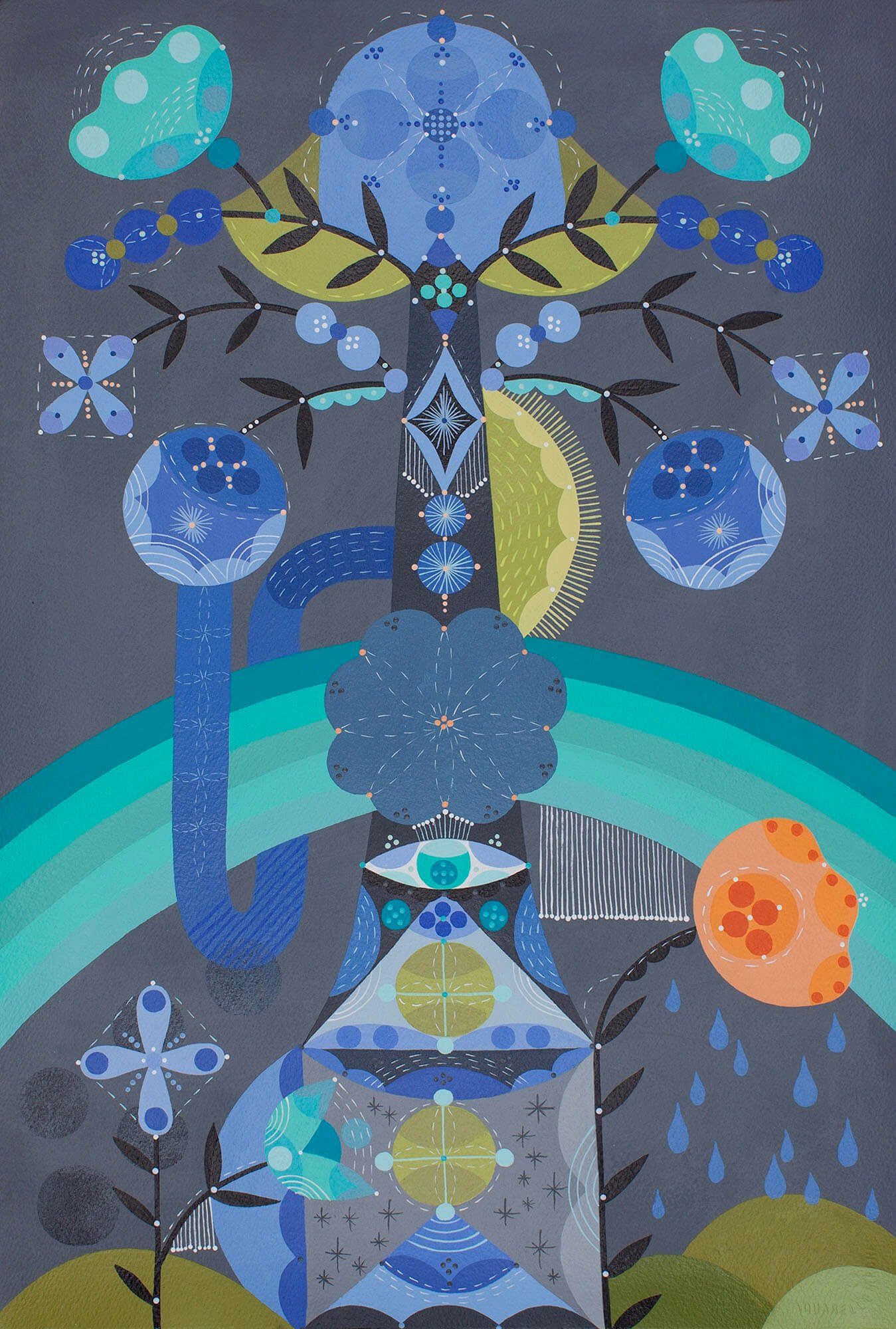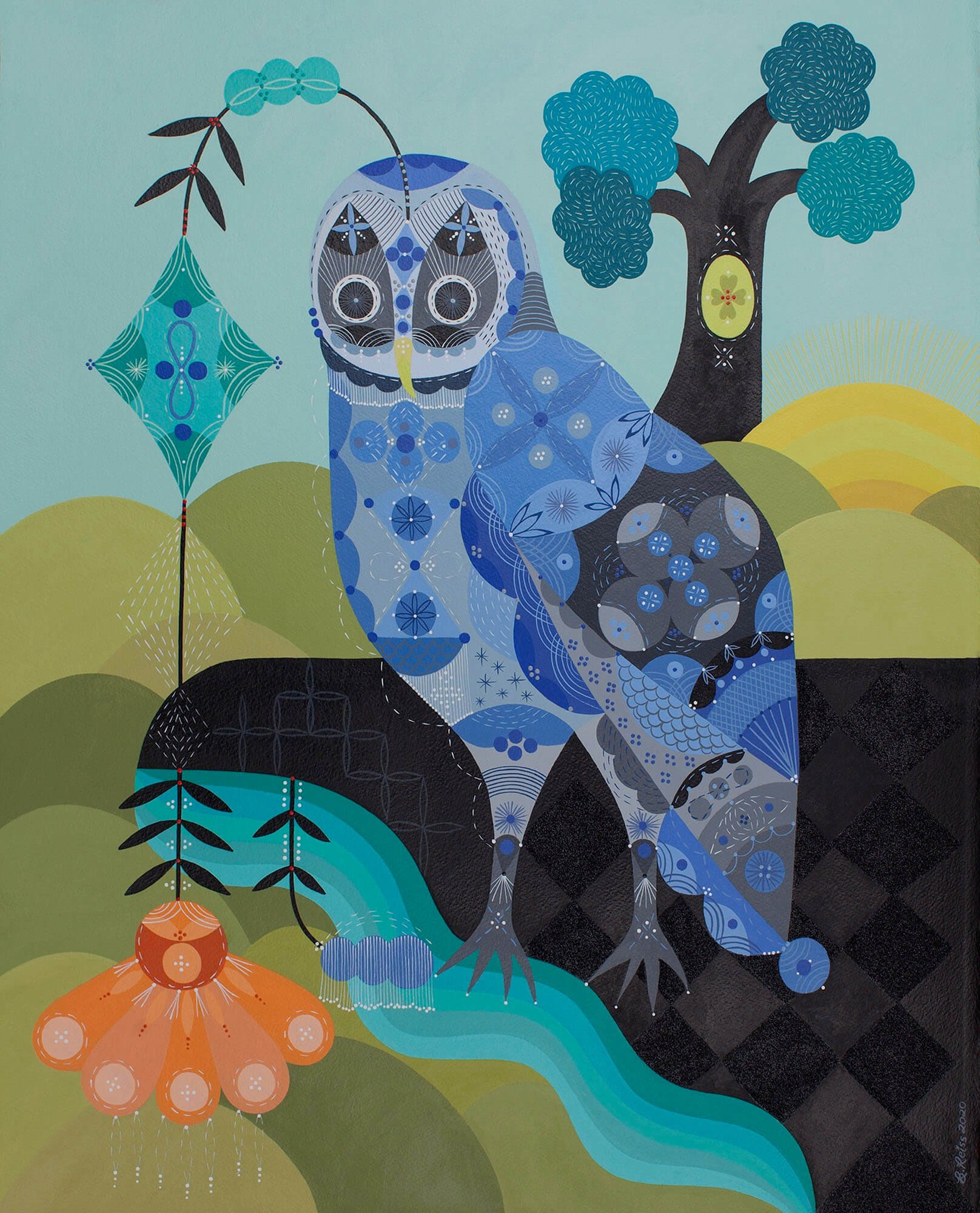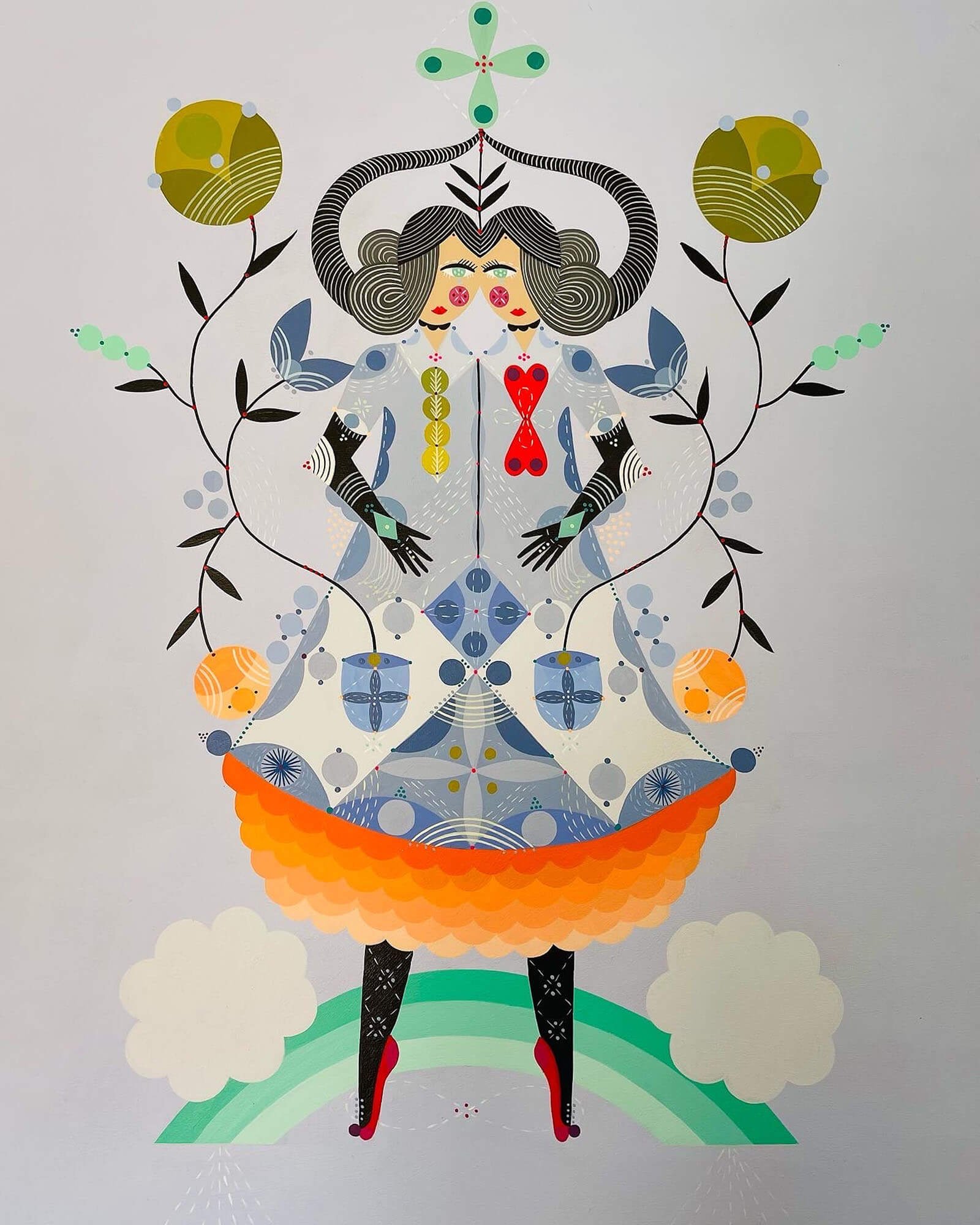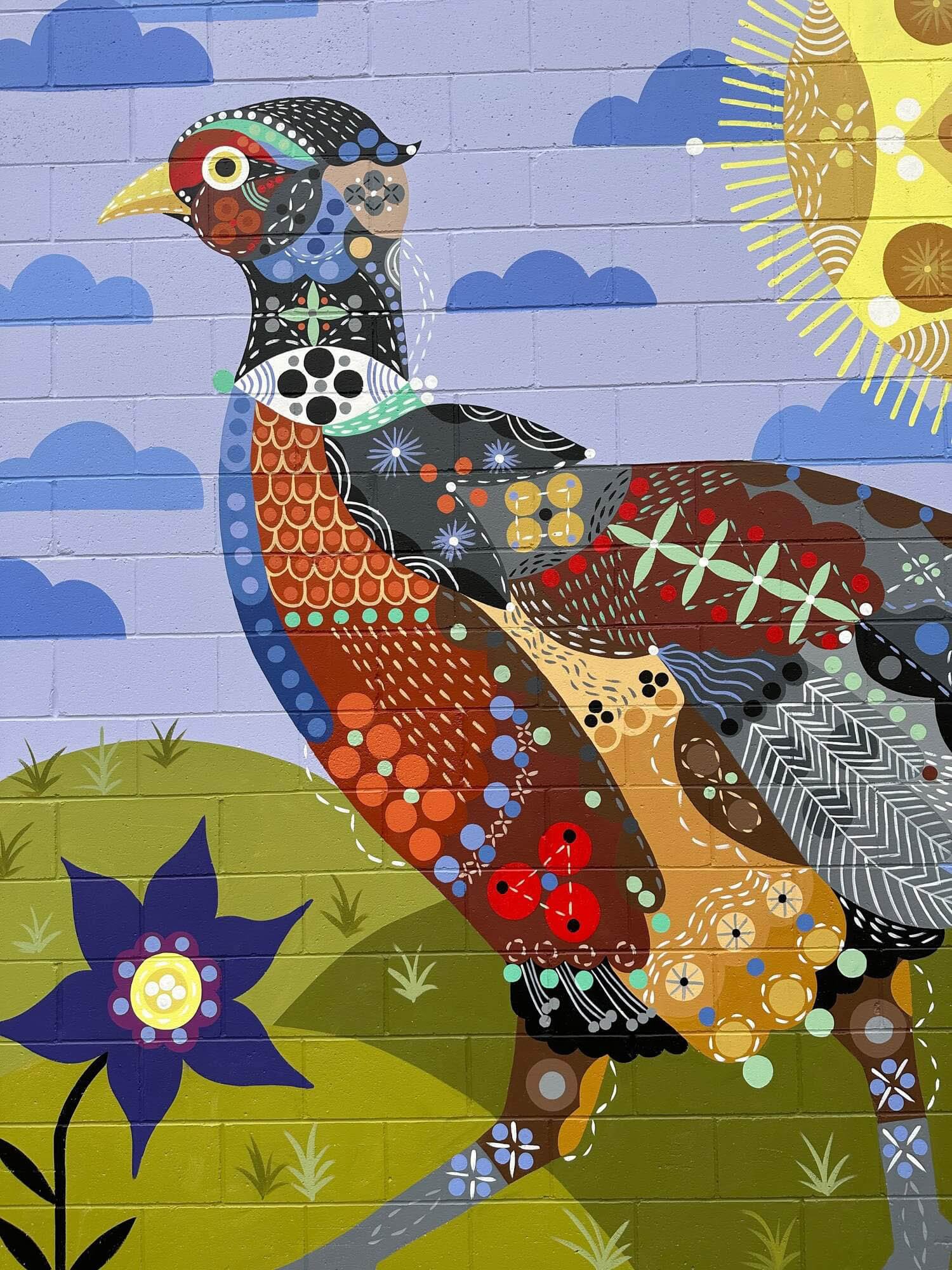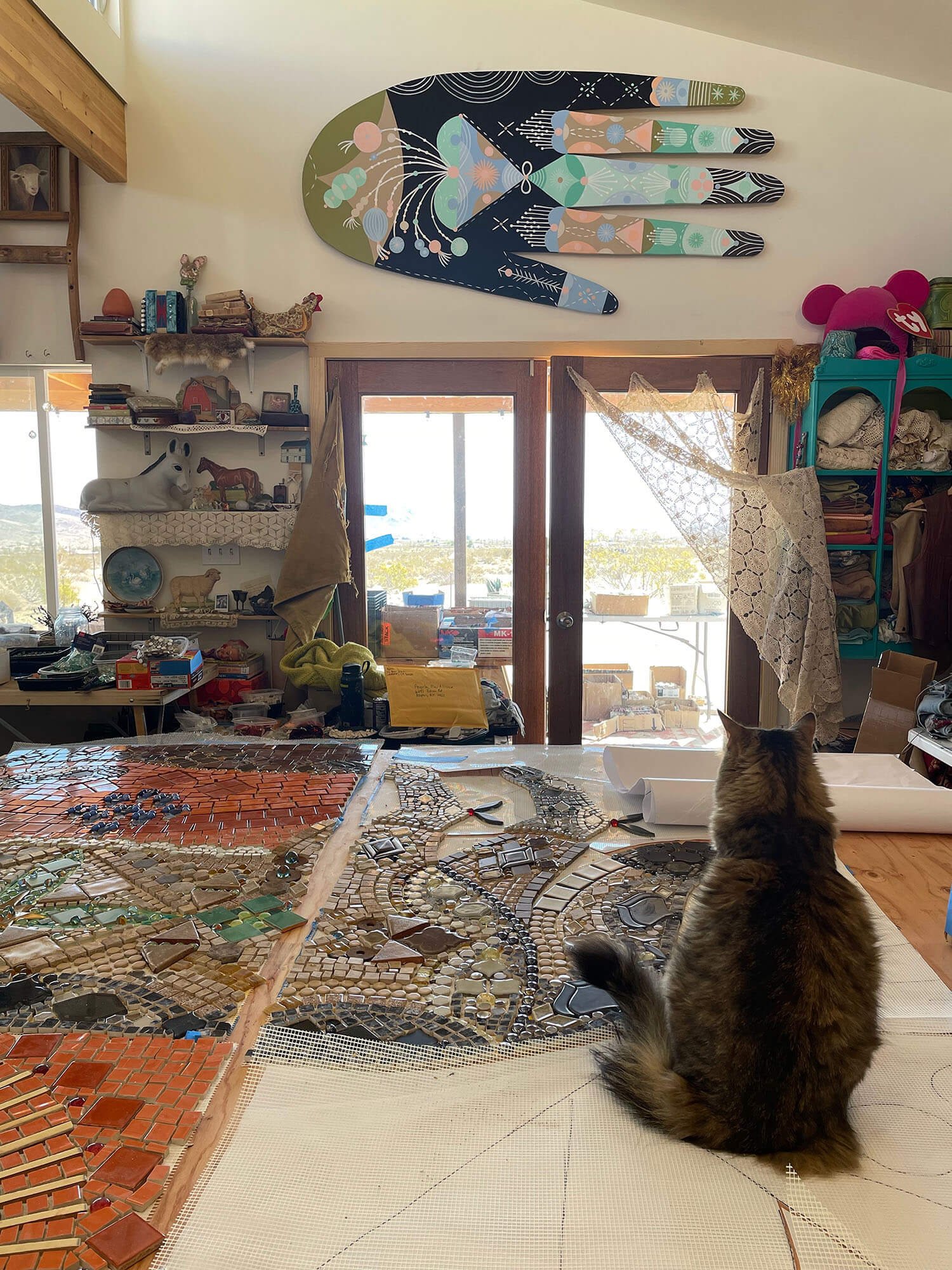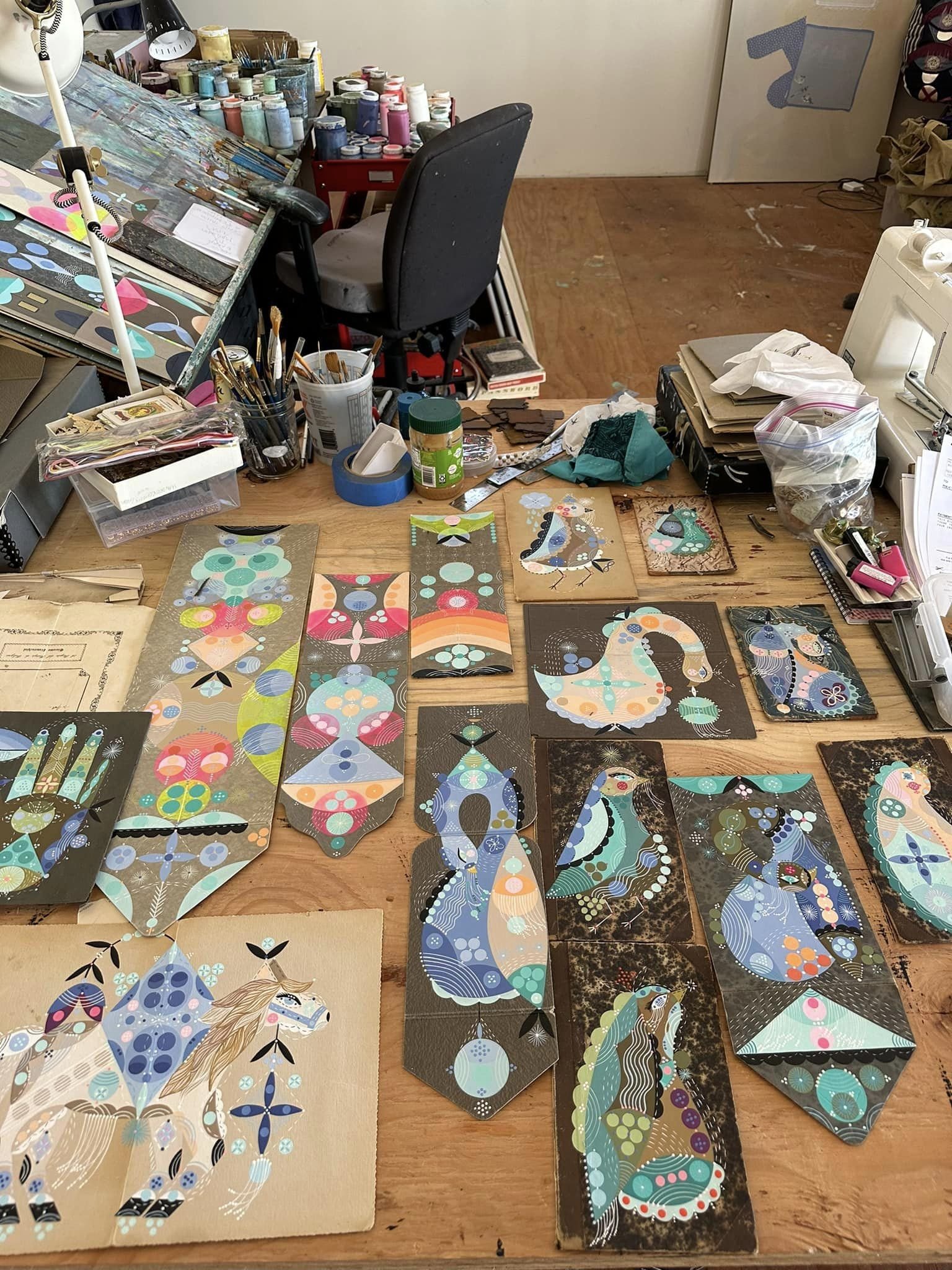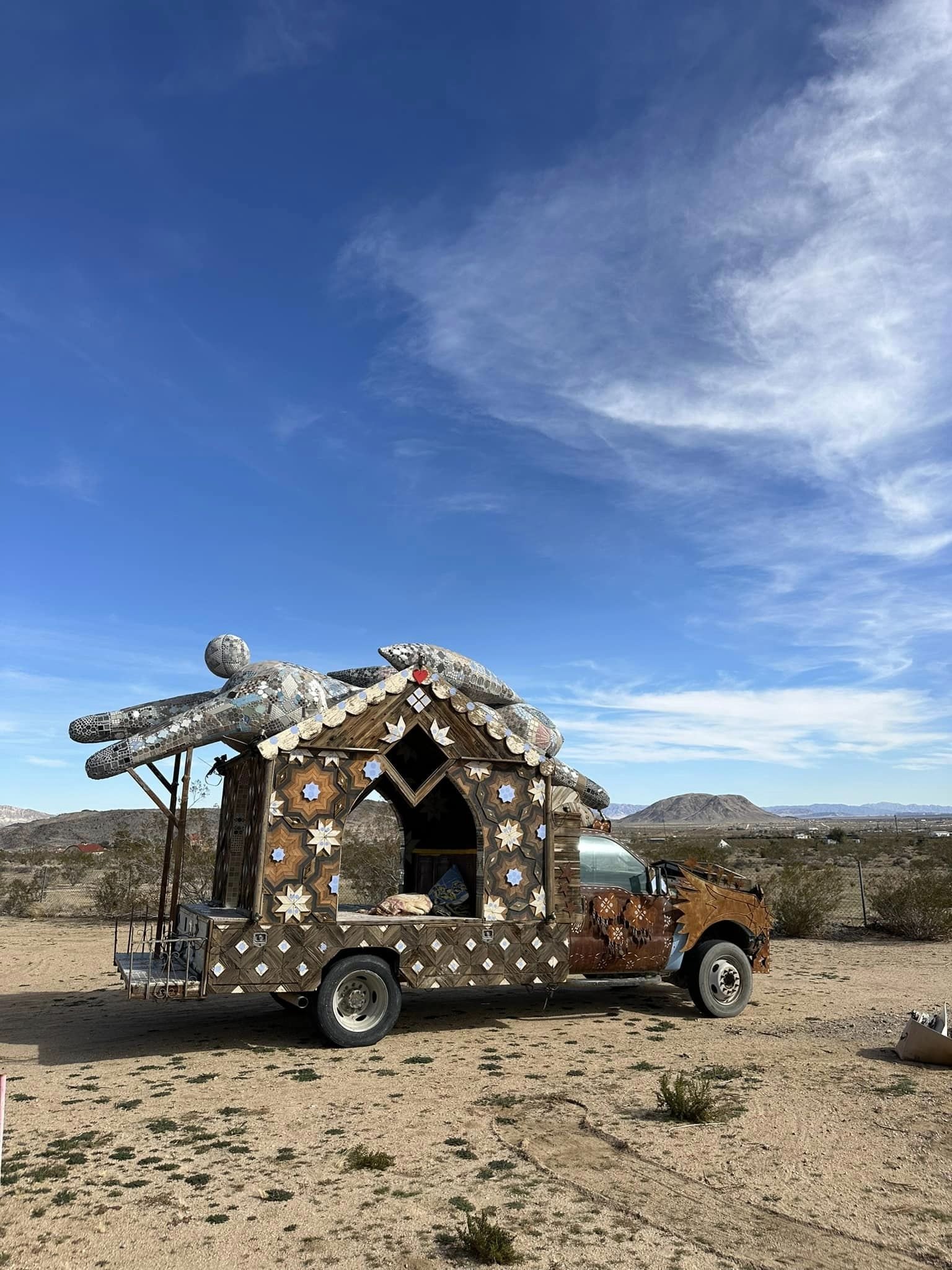Interview with artist Bunnie Reiss
The artist in her California studio. Photo by Sheva Kafai.
by Elizabeth Seward, executive editor
On January 19th, I had a chat with Bunnie Reiss. Reiss, an artist with fantastical (and often large) leanings, told me about her inspiration, process, views on art, and more. You can read the conversation below.
Bio from The Creative Independent:
“Bunnie Reiss was born in Maryland, but raised mostly in Colorado. Her work is influenced by her Eastern European background and she creates worlds full of conversations that look deeper into the investigation of self and community. She is most known for her public art, creating murals and larger installation works. When not creating in public, she has a studio practice where delicate paintings tell tales of deeper explorations into other dimensions, and the communities that exist within them. She has shown in both the United States and internationally, in galleries, alternative spaces, bookstores, abandoned buildings, and fields and forests. She is currently located in a small desert town just outside of Joshua Tree National Park, where she is slowly building up a 5 acre property known as Lilac Lane Farms.”
(Editor’s note: The following has been lightly edited for clarity.)
Your art gives me such an airy, whimsical, magical kind of feeling. It seems like it’s grounded in nature, but also fantasy, perhaps not unrelated to the background I read you have in literature. Can you tell me more about your pull toward imaginative expression and some of the value it has brought you over the years to engage in this type of creativity?
I like to believe that we are existing in many worlds at once, but it’s our choice to access the ones that we’re accessing. So, for me, whether I do it consciously or subconsciously, these are all my worlds interceding at once. And it’s everything from my spiritual voice to my political voice to my human voice to my animal voice, and they’re layered like a slide projector. So I will go back and forth within that slide projector and I just consider them consecutive lives going on at the same time. Some people call them dimensions, some people consider them portals — whatever you want to call them, whether they’re doors or they’re environments or they’re universes, I really love the idea of being able to interpret what I’m seeing in front of me through my voice. Our voices are so unique that one of the most, I think, incredible things that we can do is to hone in on our voice and speak about these things because our languages are very specific to our DNA. So, within all this conversation, it’s really just me interpreting what I see and what I feel is important in my world. And, again, that can be a lot of different kinds of discussion. I think there’s not a right or wrong way to go when expressing, it’s just about being confident in your voice and understanding that there’s only one of you, so whatever you have to say is important.
“When I paint, it is my most gracious way of sitting with myself.”
In terms of mental health, or just general wellness, how has art helped you to kind of bridge the gaps through the harder times in life?
Well, it’s interesting because I hate the cliche of saying I don’t know who I would be or what I would be if I didn’t have art as an outlet. I feel like, for me, it’s much more specific than that. You can be an artist in a lot of different ways, but I feel like the art of sitting with yourself is probably one of the most difficult forms, and when I paint, it is my most gracious way of sitting with myself. It sort of calms everything down around me. And the excuses that we make to go into our studios are connected to that meditation; they’re the excuses we use in our life in general. “Oh, I don’t feel like getting out to go for a walk because I’m tired, because I’m this, I’m that,” “Oh, I’ll just eat one more bowl of ice cream, it’s fine,” or “Oh, I’ll just look at social media until two in the morning, I didn’t do it last night, so it’s OK for me to do it tonight.” No judgment. I do all of these, and I definitely do them to the point where it’s unhealthy — between the eating and the exercising and the social media and all of it — but I think that art, for me, plays a role of tapping into a space inside of me that’s necessary to keep my brain calm. And the calmness helps me to be clear about what I’m choosing to access emotionally in this world. Because we can run on fear; we can run on anxiety; we can run on stress; we can choose all of these things, but if we have any kind of tool to choose a different avenue, then why not try it? Why not access that and see what the outcome is? That’s really where art plays a role for me, so, within that cliche, I also say, “I don’t know what I would do without it.” Because I found my meditation as a young person, just without realizing that’s what it was. It’s the act of making, but truly, it’s the act of me figuring out a safe container to sit with myself, and that’s my studio, that’s my private practice.
That is such a beautiful way to put it. And speaking of your studio, I would love to hear about what it is like engaging in that process you just described on a five-acre farm in the desert. I’m curious about how the landscape and the creatures affect your ability to achieve flow state or how they wind up in your art? What is the general impact of your surroundings out there?
I always knew that I would eventually have some kind of space in the desert. When I finally settled in Southern California/Los Angeles, I knew it would always be my home on some level, and I’d never quite felt that in all of the other places I’d lived. Everything felt very transient, just not as settled as I would have liked — it felt very unattainable; there was a lot of emotion around me. When I came to Southern California, I knew it would always be my home, and I’d have to figure out something that was outside the city because I really function well on the tension of different worlds. So, for as much quiet as I need, the quiet works because I know I can access the chaos. It’s only two hours away if I need it. It feeds me in a different way, but I can’t have it all the time. It just exhausts me if I do. So this property, I bought it seven years ago, but I actually didn’t move to it full time until three years ago, and that’s when I had my studio built. I had to figure out how to still be able to run a business — because, making art full time, regardless of what anyone thinks, is very much a business. You have your good years and your bad years. But it’s also a very vulnerable space to be in because I’m not making a commercial product. I’m not making something that consumers need. I’m making something that people want. And they want it to speak to them in the way that they want it to speak to them and there’s a lot of variables. So it’s also a really vulnerable place to be. I’m essentially spilling my guts out on the table every day when I put something out into the world and I don’t think people realize that. I think they just think that I’m an artist and that’s what artists do. They’re not really understanding that they’re getting the clearest form of me that anyone gets and in order to do that, you have to have a space to be able to do that in. And, thankfully, this property really nurtures that space for me and I think for sure it’s the animals, the sunsets, and the arid climate, but really what it is, it’s a sense of space here. Without trees, without things disrupting an energetic wavelength or a flow or a lightning bolt, or whatever you call it when you’re channeling that thing inside of you, it’s completely not interrupted in a space like this. Because it’s so vast and so open. Mojave Desert is just endless exploration. It’s huge. And, for me, I can kind of have all of the worlds that I imagined, which, again, gives me the confidence to know I’m exactly where I’m supposed to be. I’m doing exactly what I’m supposed to be doing. That mantra running through myself over and over again, and being able to sit with myself in a place where there’s lots of open space, helps me to create and it also helps me to look at the world through my eyes and through the eyes of true compassion. Because I just see suffering wherever I go and I need to be able to filter that into more of a positive conversation. Because we know about suffering and don’t need to talk about it anymore, we know about injustice, we understand, we have all these tools to speak about it over and over and over again, but I choose to talk about it very differently.
Bunnie’s acrylic paintings, objects, and murals are folk-art inspired, geometric compositions of shape, color, and cosmos that incorporate the experiences and landscapes of her life. “I’m essentially spilling my guts out on the table every day when I put something out into the world and I don’t think people realize that.”
That’s where that private language comes into play as well, but I mostly work with the idea of being grateful that I have this and that keeps me going in a way that I didn’t know. I had no idea that you could wake up and feel grateful every day and when you do, your creative force really flows out of you in a very specific way. So what this property does for me, beyond giving me the space and time that I need to feel truly at peace, is that it reminds me of how completely grateful I am that I exist in the way that I do, that I’ve chosen this way to exist and it’s working, and that the more I choose it, the more it works.
That is such an incredible way to approach it. I almost feel like you’re describing your surroundings as a blank canvas of sorts, but the city as this pull of tension when you need that. In terms of soaking up all of the negativity and the cynicism and injustice, it’s important that we’re aware, but I truly believe we can’t do too much to shift anything if we just live only in that world, without the gratitude.
Yeah, and I think too, when you give yourself space, you’re able to really dissect the difficult conversations instead of sort of blasting them out in the media for one second here and there. I understand my privilege. Clearly. I understand that I live within privilege. I understand so much around how that affects the people who don’t live in privilege and where I am in that hierarchy. Whether I’m a woman, whether I’m white — whatever these things are, I work to understand. I have my understanding and I work to understand more. And it’s really the privilege of space that I feed off of more than anything and that I can just be grateful for every morning.
That’s really beautiful. It brings me to another question I have for you as we’re talking about different lived experiences. All of those experiences come together in any given city or community, which makes me think about the mural work you’ve done. It’s fantastic and I’m curious about how you got into making these large, public pieces and the impacts you’ve seen on communities where they are?
Bunnie with her three-story flamingo mural in St. Petersburg, Florida.
Well, I really started doing it just out of pure convenience because I love to paint big and I lived in cities where I paid a million dollars for a closet and I didn’t have room for anything, so I used to paint in my bedroom. I would rip everything off the walls and put these huge canvases up and then roll them up and then I had to store them somewhere and it was just this never-ending cycle of obviously, you like to paint big, and then someone gave me a wall outside. Someone was like, “Just try it outside.”
There was so much freedom in just leaving a mark and walking away. You have no control over it. You have no control of what’s going to happen to it. You have no control of the response. People are going to love it; people are going to hate it; it really doesn’t matter. It’s just about you leaving a little bit of a conversation there and not listening to the feedback. And feedback and waves of feedback are sort of, in the end, what end up really becoming complex for an artist and people in the world. Because you’re waiting for that dopamine rush to get positive feedback, but, again, you have everything you need inside of you. So put it out there, see what happens.
Public art is a perfect environment. It’s a perfect conversation for that because you just have zero control. You just have to have the confidence to do it and then leave it. I just love so much that it just became not my problem. I put all this energy into it and it’s… not my problem. I just walk away to the next thing. It built pretty organically. I don’t have any kind of background — I’m not a street artist. I never did graffiti. I just love painting big. As I got more and more opportunities — and, I mean, I’ve painted everywhere and I took opportunities everywhere, especially when I was young, paid, not paid, weird shit, cool shit, big, small, anything anyone would give me — I would do it for the experience, but also just for the fun. And as I kind of grew my career and was awarded these bigger, interesting spaces and started making more capital on them, I started to really truly understand that my energy was vibing off of the energy of wherever I was painting.
What I didn’t realize is that it was sort of this cohesive relationship between the environment and me and if I could just slow down enough, I could feel a vibration from wherever I was painting. The smells, the tastes, the air, the sounds — everything. And because you’re painting at different times of day too, I’m a morning worker, so I’ll be at a wall at like 5 or 6 in the morning and the city is just dead. So I watch and feel the city wake up usually as I’m painting and I love it. There’s nothing like it. The other thing I didn’t take into account, which is really important to me, is that it’s like running a marathon. It’s very physical and I get the same kinds of endorphins that I get from hiking or being outside. It’s very athletic and you train your body to do this kind of work because the days are excruciatingly long sometimes and your body feels very uncomfortable at night. I don’t know many marathon runners, but I assume it feels similar. You’re really tired and your body’s physically tired but, at least for me, I know I have to get up the next day and do it again, so you have to figure out ways to calm your nervous system down, which then calms your physical down. All of it, combined with, honestly, some of the most fun I have ever. I love painting big and I love painting it outside. It is so much fun and if I could have ever imagined such a fun life for myself, I mean, it’s great. It really works for who I am, just deeply as a person, but also, it’s such a great life, truly.
I love that. I live in Portland, and we have a lot of art in Portland. I always feel like, especially with those really large pieces, whether or not someone likes it, it’s really kind of not even your business as an artist, but it sets the tone. It sets the tone of the city and the way that it feels. That’s such an interesting part — an amazing part — of public art like this. Because not everyone has access to art. So many kids grow up not even really knowing what it is, let alone that it could brighten their day on some level they can’t completely grasp just by viewing it as they drive by. The arts are so notoriously underfunded, but so impactful. As we’re doing this work here at Medicinal Media, and regularly diving into the scientific research, my mind is getting blown over and over again because I have always loved the arts, but I feel like I’m now understanding a bit of the neuroscience of why. One thing I would love, if you could share with our readers, is for those who are not involved with the arts at all, whether it’s supporting locally or even exploring art themselves, are there any suggestions you would give them of how to get involved, how to support, even in a low-cost way that you’ve found over your career to be actually impactful and helpful for tying the community together and making a real difference?
I think just going to city council meetings is really important. I think when you get involved with wherever you live then, ultimately, the conversation of art will come up because people want to beautify spaces. But in order to understand that, you have to be involved in where you live. I think that’s baseline. That’s a really great way to understand how to support the arts. How do you want your city or town to look and feel? For me, I feel like it’s important to be involved on a civic level in order to bring artists in or just to say, “I want a decorative bench in the park.” You’d be surprised how all the sudden it’s like, “Oh, we could have an artist do this” or “I know this artist and this artist.”
I think going to gallery shows is interesting, but there’s a formal quality around it that doesn’t always translate to everyone and so it’s nice to go there and see those kinds of things, but I think that developing public art programs within where you live is a really good way to understand art and how it can connect you in your hometown. I also think that buying locally is a really good option. If you have a birthday or a baby shower or a holiday or something, instead of going to a big box store, look and see where some of these smaller boutique stores are. There’s always local art in them. And there’s usually a range, so that’s always a really good way to support fiscally. But there’s something about civic stuff that I feel is important and people forget about. You want where you live to be beautiful, so be a part of it at the government level and you can have access to so much work. And it doesn’t even occur to people lots of times. That’s all on you! You can do all that for your community.
I appreciate that tip so much. I think, in general, a lot of us forget that we do have direct access points to our local governments and, maybe not immediate change, but faster moving than people realize.
Yeah! If you wanna change something, then just change it. But go through the channels to change it. You have to get inside the system to take apart the system. So, you can’t just sit back and wait for it to come to you — go to a meeting! We’ve been fighting out here in the desert these huge glamping developers that wanna come in and build these huge, crazy, 70-person camping/glamping sites and so far we’ve fought every one of them and a lot of that is just signatures and also showing up to city council meetings. There’s, like, 100 people there voicing their opinion against it. It’s very powerful and I think that people get frustrated because they’re not looking at it. They’re looking at the micro conversation and when you realize that you can really change the way people feel by putting something beautiful in your town, then you realize you have the power to change a lot of things. But you have to be involved at a civic level to do that.
That’s so true. It’s really the power to change the world. I know that’s a really big way to say it, but I wouldn’t be here if I didn’t believe it. There’s this concept that I personally do believe in, that we’re all born as artists, of one kind or another, and often it’s society that deprograms us and teaches us to assimilate into something more conventional. I’m wondering if you believe that, and, in any case, whether you do or don’t, if you have advice for people out there who do feel a yearning to tap more deeply into their inner artist, but, for whatever reason, they’re not quite there yet, but they’re feeling the pull?
“I feel like it’s important to be involved on a civic level.” —Bunnie Reiss
Yeah, I don’t think I’m any different than anyone else. I just think that I have figured out a way to access a part of myself that feels really good and instead of rejecting what feels good, which I unfortunately feel like a lot of people do, unbeknownst to themselves — they don’t realize they’re doing that. When you access things that feel good, I think it can surprise you, what comes out of you. We don’t have infinite time on this plane. We just don’t. There are just no guarantees and I think over the last couple years, that became more apparent and there was something really powerful about it and, with everything that’s going on in the world, every single day, it’s more and more reason for people to say: why am I doing what I’m doing? If you can ask yourself that, then I think you can access just about anything, whether it’s creativity or any other kind of want or need that you might have for yourself, you can access any of that. It’s in there. But you have to make that decision, that now is the time to do it and not to delay. If it feels good, then why not?
I think for artists, the hardest thing for them to do is just to do it. If you have an idea, just do it. That’s the hardest thing. I don’t come from a place where I have access to lots of financial help. I don’t have endless skills. I don’t have endless time. I don’t have a wealth of all of these things. I’m dipping into the pool of myself and that is the most abundant place to access when you have an idea. Just do it! Who cares? And if you fail, then you do. And maybe you’ll do it again, maybe you won’t, but at least you did it once. I bet you’ll do something else and then go back to it. You figure these things out.
“You have everything you need inside of you. So put it out there, see what happens.”
That’s such a liberating framework. I’m really grateful for your words and I’m listening to Rick Rubin’s book right now and I’m also grateful for his words. All of this wisdom that’s coming from artists who have actually gone through this process of learning how to turn inward and trust their vision.
And going through it! Not only have gone through it, but continually going through it. It’s never just OK. I wouldn’t say it’s a battle, but there’s always a question. And what you learn to love are the questions. You just have to find that love in yourself. You have to find it in the small, reasonable things that make you demand the impossible for yourself and for this world. And until you decide to do that, then you will cripple yourself, but when you do, it opens up everything to you.
It’s a spectacular path of growth that a lot of artists, if they do persevere, will experience. And I do think it has transformative power for all of society, beyond art, to remember to just kind of tune in first and slow down. This all makes me wonder about a very young version of you, as an artist, and what this process of becoming has been like. If she saw your recent spread in Hi-Fructose, what she would think about all of this?
That’s out of my wildest dreams. I could have never imagined a life like this, never. And for all of the things and time and all the hard work, I wouldn’t change a single thing, but I had no idea that I would ever live in a world with so much possibility. And so much choice! I just couldn’t possibly imagine that. I’m incredibly grateful for the support that I’ve gotten from my family and my friends. Just believing in me and telling me it’s going to be OK. Picking up those phones real late at night when I’m panicking and putting a ridiculous amount of pressure on myself that was unnecessary and also dealing with me when I’m not the greatest person. I’m so grateful that people stuck with me and truly believed that we can do all of this together. But I could have never imagined and I’m still kind of in shock about the article. It’s barely been on newsstands and I just, I don’t know! I feel slightly embarrassed from the vanity of it, but also I just can’t fathom actually being recognized like that. I don’t think the little, weird, crazy, insecure child who couldn’t understand why she didn’t fit in would ever be honored in such a way. It’s pretty insane. It’s pretty incredible.
It is incredible! What would you tell her today? We all have our inner child and hopefully we’re doing the work of talking to them all the time, but it’s something I’m kind of fresh into learning how to do and I find it so captivating, this idea that we can — like you began this conversation by saying — exist in these multiple planes, including our past selves.
Just have fun! Just have a good time. It’s short. It’s fleeting. Have fun! Have the best time of your life.



